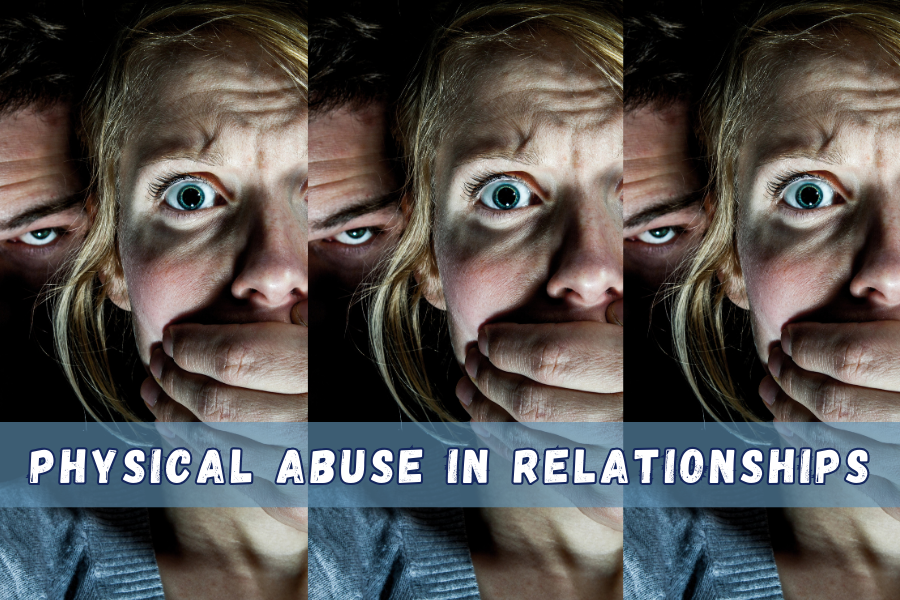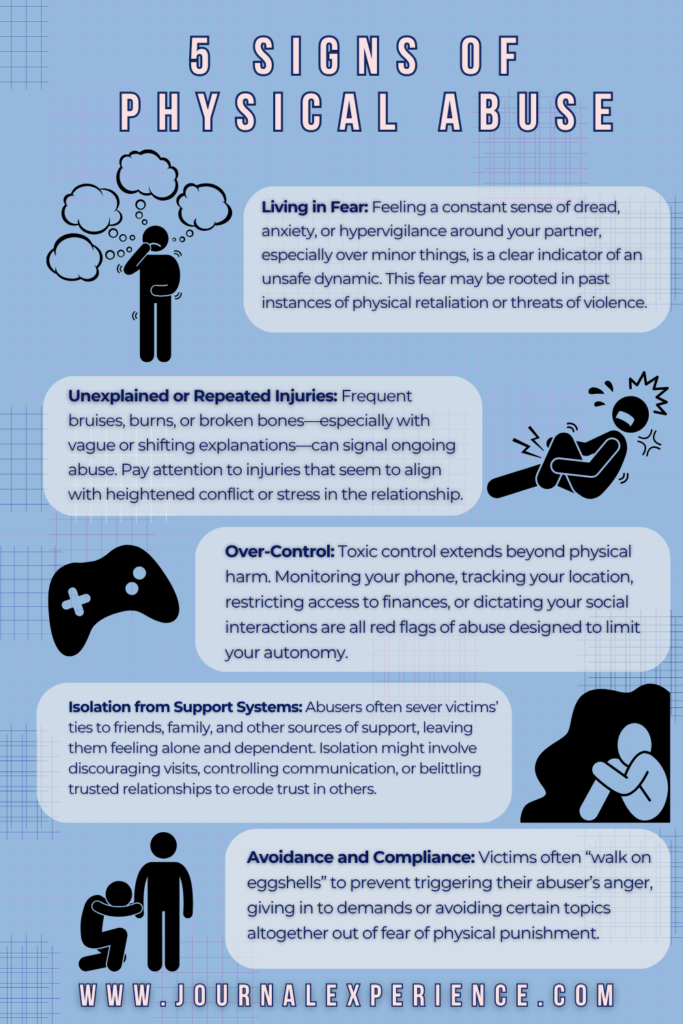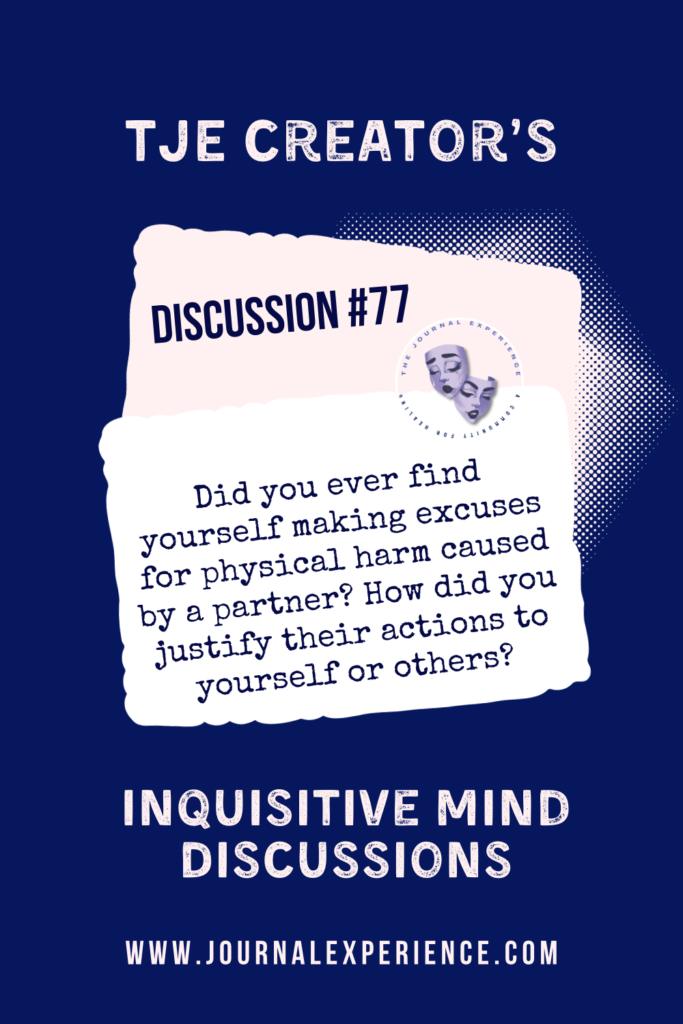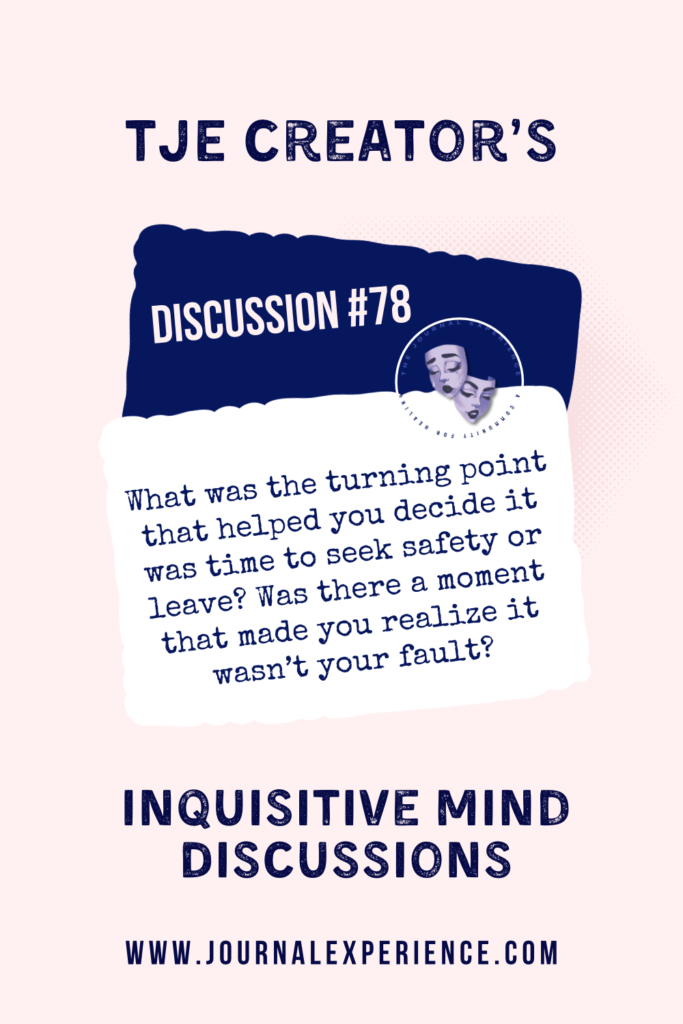Physical abuse is one of the most devastating aspects of toxic relationships, leaving both visible and invisible scars on those who experience it.

For survivors, the journey of overcoming abuse involves not only physical healing but also addressing the emotional and psychological wounds inflicted during the relationship. This post will help you recognize the signs of physical abuse, explore options for getting help, understand the legal protections available, and begin rebuilding your life in a healthier and safer way.
Understanding Signs of Physical Abuse
In toxic relationships, physical abuse often goes hand-in-hand with manipulation and control, creating an environment where victims may struggle to recognize the extent of the harm being inflicted. Abusers use physical violence as a means to assert dominance, instill fear, and maintain control, often masking their behavior with excuses or apologies. Recognizing the signs of physical abuse is essential to breaking the cycle:
- Unexplained or Repeated Injuries: Frequent bruises, burns, or broken bones—especially with vague or shifting explanations—can signal ongoing abuse. Pay attention to injuries that seem to align with heightened conflict or stress in the relationship.
- Living in Fear: Feeling a constant sense of dread, anxiety, or hypervigilance around your partner, especially over minor things, is a clear indicator of an unsafe dynamic. This fear may be rooted in past instances of physical retaliation or threats of violence.
- Isolation from Support Systems: Abusers often sever victims’ ties to friends, family, and other sources of support, leaving them feeling alone and dependent. Isolation might involve discouraging visits, controlling communication, or belittling trusted relationships to erode trust in others.
- Over-Control: Toxic control extends beyond physical harm. Monitoring your phone, tracking your location, restricting access to finances, or dictating your social interactions are all red flags of abuse designed to limit your autonomy.
- Avoidance and Compliance: Victims often “walk on eggshells” to prevent triggering their abuser’s anger, giving in to demands or avoiding certain topics altogether out of fear of physical punishment.
For those living in toxic relationships, these behaviors might feel like an everyday reality, but recognizing them is the crucial first step toward reclaiming your sense of safety and self-worth. Identifying these patterns can empower you to seek help and begin taking steps toward freedom and healing.

Getting Help While in a Toxic Relationship
Leaving an abusive, toxic relationship can feel overwhelming. Abusers often manipulate their victims into believing they are trapped or undeserving of a better life. However, resources and support are available to help you break free:
- Hotlines and Crisis Support: The National Domestic Violence Hotline (1-800-799-SAFE) provides 24/7 confidential support for individuals experiencing abuse. They offer compassionate guidance and help you create a personalized safety plan tailored to your unique situation.
- Emergency Shelters: Many shelters provide not just a safe haven but also comprehensive services, including counseling, legal aid, career training, and childcare, empowering survivors to rebuild their lives with stability and confidence.
- Trusted Allies: Confiding in someone you trust—a friend, family member, coworker, or spiritual advisor—can provide a crucial emotional anchor and practical assistance, such as transportation, temporary housing, or help gathering necessary documents.
- Therapy and Support Groups: A therapist experienced in abuse recovery can help you work through the emotional trauma and regain your sense of self. Support groups connect you with others who understand your experience, offering a shared space for encouragement and strength.
- Safety Planning: If you’re not ready to leave, creating a safety plan is essential. This may include setting aside emergency money, gathering important documents (IDs, financial records), and preparing a go-bag with necessities like clothes, medications, and a phone charger.
Remember, leaving a toxic relationship is a process, and every small step you take toward safety and healing is a step toward reclaiming your life and your future.

Consider using the 300 Mindfulness Worksheets as a supportive tool during this process—helping you reflect, build resilience, and regulate stress responses.
Legal Protections for Survivors of Abuse
The legal system exists to protect victims of abuse and hold abusers accountable. While taking legal action may feel intimidating, understanding your rights can provide a sense of empowerment and safety:
- Protective Orders: Also known as restraining orders, these legal documents can prohibit an abuser from contacting or approaching you. Protective orders often include additional measures, such as preventing the abuser from entering shared residences or interfering with child custody arrangements. Violating these orders is a criminal offense and can result in immediate legal consequences.
- Criminal Consequences: Physical abuse is a serious crime. Pressing charges against an abuser can lead to fines, jail time, or court-mandated rehabilitation programs designed to address violent behavior. Filing a police report ensures there is a record of the abuse, which can strengthen your case in court.
- Custody and Property Rights: If children are involved, family courts prioritize their safety and well-being. This may result in granting sole custody to the non-abusive parent or supervised visitation for the abuser. Additionally, courts can address property and financial disputes, ensuring you retain access to shared assets and resources necessary for rebuilding your life.
- Victim Advocacy Programs: Many organizations offer free legal aid and advocacy services, including assistance with filing protective orders, navigating custody disputes, and understanding your legal rights. Victim advocates provide emotional support and ensure you don’t face the legal system alone.
Taking legal action isn’t just about punishment—it’s about creating boundaries, ensuring safety, and securing justice. These protections empower survivors to rebuild their lives with the confidence and security they deserve.

If you or someone you know works in advocacy or counseling, the Trauma Sensitive Mindfulness Certification provides tools to support survivors with compassion and clarity.
Healing After Leaving a Toxic Relationship
The journey of healing after leaving a toxic relationship is deeply personal and often challenging. Survivors may face a whirlwind of emotions—guilt, shame, anger, or grief—as they process the trauma and begin to rebuild their lives. However, healing is possible, and these strategies can support your path forward:
- Counseling and Therapy: Working with a trauma-informed therapist can help you navigate the emotional scars left by abuse. Therapy provides a safe space to explore your feelings, develop healthy coping mechanisms, and rebuild self-esteem. Group therapy or support groups can also connect you with others who understand your experience.
- Building a Support Network: Reaching out to trusted friends, family members, or fellow survivors can provide comfort and encouragement. Surrounding yourself with a supportive community reminds you that you’re not alone and that others genuinely care about your well-being.
- Self-Care Practices: Prioritize activities that restore balance and peace to your life. Journaling can help you process emotions, mindfulness can ease anxiety, and physical activity like yoga or walking can release stress. Explore creative outlets such as painting, music, or writing to express yourself and reconnect with joy.
Try the 200 Guided Meditation Scripts to cultivate grounding, presence, and emotional safety during your recovery.
- Setting Boundaries: Learning to establish and enforce personal boundaries is essential for creating a safe and healthy environment moving forward. Boundaries help protect your emotional and physical well-being and prevent the reemergence of toxic dynamics in future relationships.
- Rediscovering Your Identity: Toxic relationships often erode self-confidence and suppress individuality. Take time to reconnect with your passions, values, and goals. Whether it’s exploring a new hobby, pursuing a long-held dream, or simply enjoying activities you love, reclaiming your identity is a vital step toward healing.
Healing is not a linear process—it’s a journey that requires patience and self-compassion. Celebrate the small victories along the way, honor your progress, and remember that every step you take is a testament to your strength and resilience. You are building a life that values your safety, happiness, and freedom.
Preventing Future Toxic Relationships
After leaving a toxic relationship, it’s common to fear falling back into similar patterns. The good news is that with self-awareness and education, you can take steps to prevent this from happening.
Learn Red Flags: When you’ve experienced toxic dynamics, it can be easy to overlook or ignore early warning signs in a new relationship. Recognizing red flags, like possessiveness, excessive jealousy, and boundary violations, becomes essential in spotting harmful patterns before they take root. Trusting your instincts can protect you from repeating history.
Define Healthy Relationship Standards: Having been through toxic relationships, you’ve gained insight into what doesn’t work. Now it’s time to focus on what does. A healthy relationship is built on mutual respect, trust, communication, and equality. Take the time to define these qualities for yourself, understanding exactly what you need in order to feel safe and valued.
Focus on Self-Growth: Your journey toward healing and growth is key in avoiding future toxic dynamics. Reflect on your values, passions, and goals. By strengthening your sense of self and building your self-esteem, you’ll be less likely to tolerate harmful behaviors. When you know your worth, it becomes easier to recognize when someone isn’t treating you with the respect you deserve.
Seek Therapy: If patterns from toxic relationships still linger, therapy can be a transformative tool. It can help you unravel the roots of past trauma and work through unresolved issues that may influence your choices. A therapist can guide you in breaking unhealthy cycles and finding healthier ways to approach future relationships.
Surround Yourself with Positive Influences: Healing from toxic relationships requires support, and it’s important to nurture friendships and connections that uplift you. Being surrounded by people who respect and support you will help reinforce your understanding of healthy boundaries, making it easier to spot toxic behavior early on.
Prevention isn’t about living in fear—it’s about empowerment. By learning from past experiences, trusting your instincts, and setting clear boundaries, you can create the foundation for healthier, more fulfilling relationships in the future.
Overview
Experiencing physical abuse in a toxic relationship is a painful and isolating experience, but it does not define your worth or your future. Recognizing the signs of abuse, seeking help, and embracing the journey of healing are all courageous steps toward a brighter tomorrow.
If you’re walking this path, consider exploring the Mindfulness Meditation Teacher Training Program—a deeper practice to guide both your recovery and your future.
If you’re ready to take the next step in your recovery, consider becoming a member of The Journal Experience or subscribing to the TJE Newsletter. Our community offers tools, resources, and support to help you heal, grow, and reclaim your power. You don’t have to face this alone—together, we can create a space of safety, empowerment, and hope.